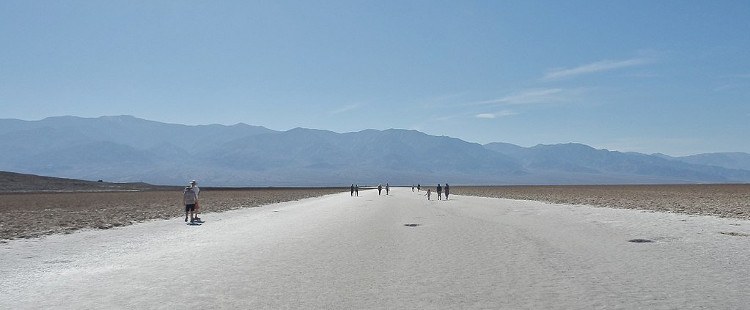06/29/2018
Read Time: Minutes

This is a story of unfortunate decisions and lack of preparation in one of the most inhospitable regions on Earth. In July 1996, 4 German tourists disappeared in the unforgiving wilderness of the infamous Death Valley in the US state of California. Their fate remained unclear for a long time. A few years ago, the mystery of the disappearance of the 4-member family, known in US media as the “Death Valley Germans,” was finally solved.
The family consisted of 34-year-old architect Egbert Rimkus, his 28-year-old girlfriend Cornelia “Conny” Meyer, along with his 8-year-old son Georg Weber and Cornelia’s 4-year-old son Max Meyer, who were on a 3-week vacation in the USA. The newly formed couple lived in Dresden. Subsequent investigations shed light on the days before their disappearance.
They began their journey at Frankfurt Airport. After a short stopover in Seattle, where they landed on July 8, they continued towards Los Angeles. On site, the 4 Germans rented a car and, as suggested by pictures from their found camera, drove to the Californian coast before visiting the Treasure Island Hotel in Las Vegas. On July 22, they checked out and headed towards Death Valley. Their destination was likely Yosemite National Park.
Death Valley – in German, “Tal des Todes” – became part of one of the largest national parks in the USA in 1994. The Death Valley National Park, spanning an area of more than 13,000 km² and attracting over a million visitors annually, is one of the hottest places on Earth. As if that wasn’t enough, the valley experienced a 40-day record-breaking heatwave with temperatures reaching up to 55°C during the summer of 1996.
At the same time that Egbert Rimkus and his small family reached Death Valley, the annual Badwater 135 ultramarathon was taking place. In this ultramarathon, athletes run 135 miles (217 km) through Death Valley up to the Whitney Portal at Mount Whitney. It’s considered one of the toughest races in the world.

Badwater Basin – Site of the Badwater 135 Ultramarathon | © Alexander Migl / CC BY-SA 4.0 / Wikimedia Commons
Unlike the 4 Germans, the marathon runners had prepared for the ordeal through the California valley for months. Furthermore, they were accompanied at every step through the scorching hot Death Valley by support teams. Egbert Rimkus, his girlfriend Conny, and her 2 children, on the other hand, were entirely on their own, equipped only with two simplified tourist maps and far too little provisions. This was to be their downfall.
The car rental company, Dollar Car Rentals, reported the car, which was due to be returned on July 26, as stolen on September 10. They typically waited 30 days after the return deadline before reporting a leased vehicle to the police.
Egbert Rimkus’ ex-wife, Heike Weber, began to worry when her son Georg didn’t come home on July 27 and contacted her ex-husband’s travel agency. The German travel agency inquired about the 4 Germans at Dollar Car Rentals, but no employee could provide any information.
Heike Weber feared that her ex-husband wanted to escape abroad with their son. She described him as an adventurer and daredevil and believed he was clever enough to devise a plan to disappear with their son. On August 14, the German travel agency and the car rental company reported the German tourists missing to Interpol. There was no hot lead at that time.
This changed almost 3 months later, on October 21, 1996, when Death Valley National Park Ranger Dave Brenner flew in a helicopter over the southern part of Death Valley. The park ranger was not looking for the 4 Germans but was on a mission to locate drug labs. Yet, he was the first to discover the green Plymouth in Anvil Canyon, far from any official road. Brenner wondered what the family car, completely unsuitable for this terrain, was doing there.
He landed his helicopter and examined the apparently long-abandoned Plymouth. He found signs that the 4 Germans had spent some time at this location. Food packaging, toilet paper, and feces were near the dust-covered Plymouth.
The 4 tourists from Germany were quickly identified based on the license plate, and in the following days, a large-scale search involving 250 people began for Egbert Rimkus, Cornelia Meyer, Georg Weber, and Max Meyer. The search teams combed the area where they suspected the missing to be for days. They found only an empty beer bottle in the sand that they could attribute to the Germans; otherwise, there was no trace.
In the years that followed, there were further both official and private search efforts, but success remained elusive. It wasn’t until 2009, when Search and Rescue worker for Los Angeles County, Tom Mahood, became aware of the case, that a breakthrough was achieved, and the fate of Egbert Rimkus, Cornelia Meyer, and their sons could finally be clarified after 13 years.
Tom Mahood developed a theory of how the tragic accident might have occurred:
“The most probable scenario is that they left Hanaupah Canyon on the morning of July 23 and headed south towards the Warm Spring Road to then continue west. At this point, they would have encountered a narrow gravel road. They likely made a stop at Warm Spring Camp, thinking they could inquire about the road conditions further west. Instead, they found Warm Spring Camp abandoned and left an entry in the guestbook, indicating they continued towards Mengle Pass.
Then they drove west towards Butte Valley. They must have encountered poor road conditions there as well before discovering the so-called Stone Cabin. At the Stone Cabin, they probably made another attempt to inquire about the road conditions on their way. However, it was also deserted. They decided to take a flag as a souvenir from the Stone Cabin and then drive towards Mengle Pass.
When they reached Mengle Pass, they quickly realized it was impossible to continue with their car. In their travel guide, Mengle Pass was not marked differently from the roads they had previously traveled, so there was no reason for the group to believe that Mengle Pass was impassable.
So, they had to turn back. Egbert checked the travel guide for the fastest way back. He found an alternative, shorter route back to the valley, and they set off towards Anvil Canyon. Of course, this was not a good route, especially in the late afternoon as daylight was fading.
The Germans returned to the crossroads at Stone Cabin and turned onto Anvil Canyon Road. They were probably in a hurry by now, wanting to reach Yosemite National Park as early as possible. That’s why they were driving much too fast for the poor road conditions, and large rocks destroyed 3 of their tires. With 3 flat tires, it was impossible for them to continue.
Perhaps Egbert saw on the tourist map the northern border of the China Lake Naval Weapons Center (NWC), which was only 8 or 9 miles south of them. One can easily imagine how he climbed the surrounding hills and looked south to discover the military facility promising safety in the distance.
The group likely spent a night in the rental car and set off early the next morning in search of help towards China Lake NWC.”
Rescue teams in previous years ruled out the possibility that Egbert Rimkus and Cornelia Meyer headed in that direction, and therefore, an official search was never conducted near the China Lake Naval Weapons Center.
Tom Mahood concluded that this was the most probable route taken by the Germans. Egbert and Cornelia probably thought that the military facility was occupied by soldiers and staff. However, this was not the case.
Mahood and his search partner Les Walker spent hours scouring the inhospitable area around the China Lake NWC. Eventually, they found remains southeast of the military facility and 8 miles from the Plymouth, in a remote area called Goler Wash. The discovered bones were identified as Egbert Rimkus and Cornelia Meyer. Next to their remains were the travel guide, empty beer bottles, and 2 empty water containers. Additional bones were found, likely belonging to the children, but not enough DNA could be extracted for identification.
Report on Tom Mahood and Les Walker, who found the family’s remains after 13 years
After 13 years of uncertainty, the relatives finally learned the fate that befell the family from Dresden. Egbert Rimkus and Cornelia Meyer underestimated the unforgiving wilderness of Death Valley and did not adequately prepare for the passage, recommended only for local drivers with off-road vehicles. Unfortunate decisions followed, like attempting to drive to the impassable Mengle Pass and the trek to the deserted China Lake NWC, partly encouraged by a simplified travel guide.
The 4 Germans were not the only tourists to suffer this terrible fate in Death Valley. In the last 20 years alone, there have been at least a dozen heat-related deaths in the Valley of Death and many more incidents that almost led to death.